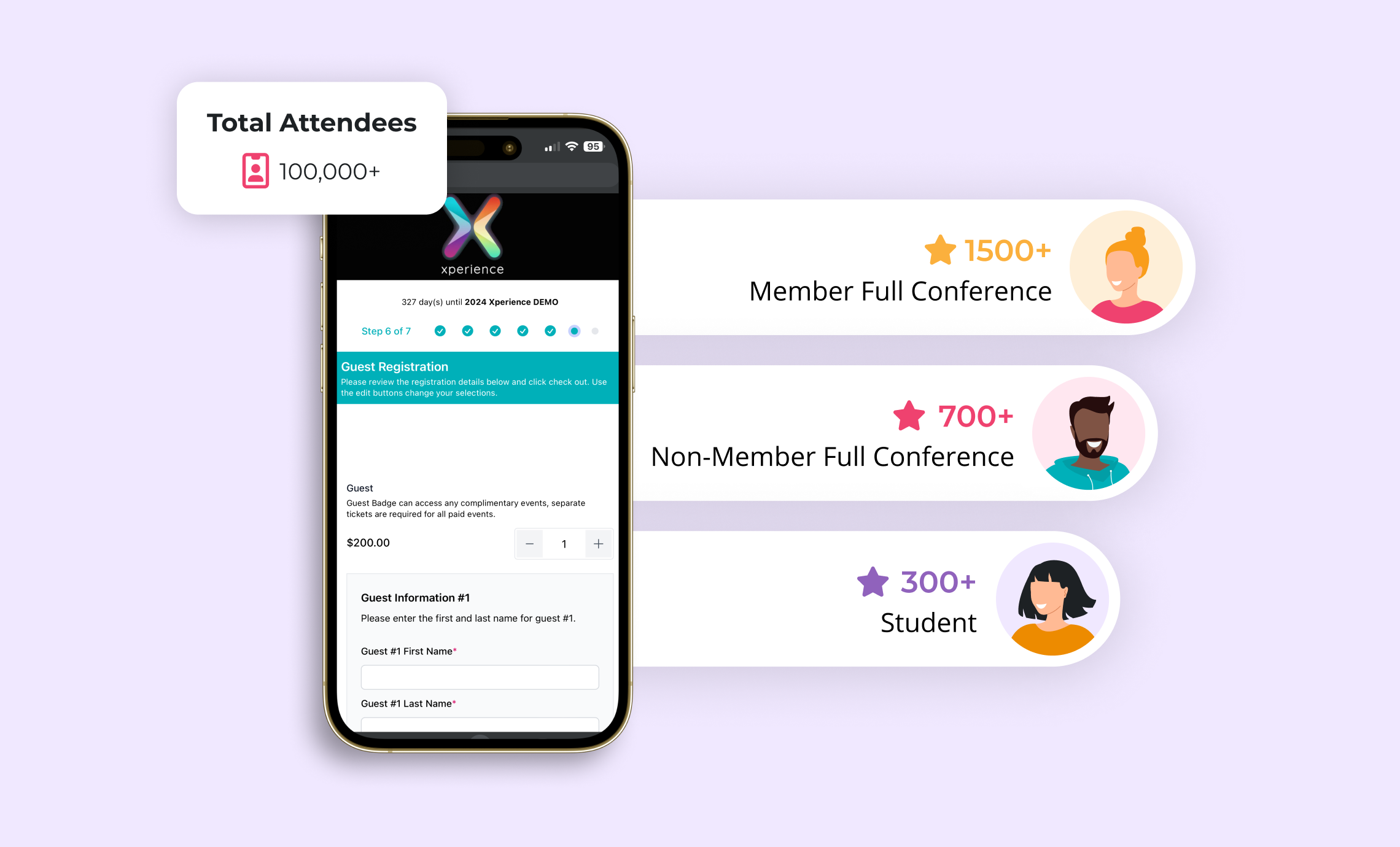Are you tired of dealing with complicated, confusing event attendance tracking processes? You’re far from alone. Thankfully, with the right events planning solutions, you can take control of the entire attendee experience. By making it easy and hassle-free for attendees. All the while providing clients and sponsors with valuable insights and cementing your reputation as an A-list event planner.
The following guide to event attendance tracking will show you how event technology can optimize the experience for all stakeholders. In addition, will make tracking events simple and streamlined, including by helping you track attendance. By implementing the right tools and solutions, you can say farewell to the frustration of attendance tracking with a far smoother and more efficient process.
Why track attendance?
Tracking attendance at events is among the most key elements of event planning. It not only helps attendees fulfill any required education. It also provides valuable insights for businesses to understand their successes and losses.
For attendees, tracking attendance can be beneficial in ensuring they are meeting any necessary requirements for continuing education or certifications. By having accurate attendance records, attendees can be sure they are receiving credit for the events they have attended. Additionally, tracking attendance can also help attendees and event organizers identify potential issues or areas of improvement for future events.
For businesses, tracking attendance provides valuable data that can be used to understand the success of an event. Businesses can learn about their audience and track attendance trends, which then can be used to make informed decisions about future events. For example, if attendance is consistently low for a certain type of event, it may be worth considering changing the format or location to better suit the audience. On the other hand, if attendance is consistently high, it may be worth expanding the event or offering similar events in the future.
Furthermore, tracking attendance can also provide important information for sponsors, exhibitors and vendors. They can use attendance data to evaluate the effectiveness of their participation in the event. It also allows them to make informed decisions about future sponsorship opportunities.
Overall, tracking attendance is a valuable tool for both attendees and businesses. It helps attendees fulfill any required education, and it allows businesses to learn from data and understand the success of an event.
Types of event attendance tracking
When it comes to tracking attendance at events, there are several options available. Each has its own set of pros and cons and your choice depends on the specific needs of the event.
One of the most basic methods of tracking attendance is also the most old-school: pencil and paper. This method is simple, inexpensive, and doesn’t require any special equipment. However, it can be time-consuming, and it may be difficult to keep the records accurate and organized.
Another option for tracking attendance is to use electronic devices such as smartphones, tablets, or laptops. These can be used to register attendees, scan tickets, and check-in attendees using QR codes or facial recognition. This method is faster and more accurate than using pencil and paper. However, it can be more expensive and requires more preparation and training.
Electronic badges and wristbands are also commonly used for event attendance tracking. These can be used to check-in attendees, track their movements throughout the event, and monitor capacity. Electronic badges and wristbands can also be used for access control and security purposes. However, electronic badges and wristbands can get costly and may require additional equipment and training.
Ultimately, the type of attendance tracking you choose for an event will depend on the specific needs of the event. Factors such as event size, budget, and the type of event should be considered when choosing the best method of tracking attendance.
How to choose the best event tracking option for you
When it comes to tracking attendance at events, it’s important to choose the right option that best suits your event’s size, needs and type, budget, and attendees’ preferences.
Event size and type are the first and foremost factors to consider when choosing an attendance tracking option. A small-scale event may only require a simple pen and paper system, while a larger event may necessitate a more advanced electronic system. Additionally, consider the type of event — for example, a conference will have different requirements than a concert.
Budget and time are also crucial factors when choosing an attendance tracking option. Some methods, such as electronic badges or wristbands, can be more expensive and require more setup time, while others, like pencil and paper, are more cost-effective and require less time. It’s important to consider the cost and time investment before deciding.
Lastly, attendee trust is an important aspect to consider when choosing an attendance tracking option. Modern solutions such as electronic badges or facial recognition can build confidence among attendees. This provides accurate, fast, and secure check-ins. However, some attendees may be hesitant to adopt newer technologies, so it’s important to consider their preferences and choose an option that they are comfortable with.
By considering these factors, you can make an informed decision and choose the best event tracking option that fits your event’s needs and budget while providing a positive experience for attendees.
Contact guests ahead of time
Contacting guests ahead of time is an important step in ensuring a successful event. It allows you to set yourself up for success by prepping your guests and providing them with all the necessary information they need to know before they arrive.
One of the best ways to contact guests ahead of time is by email. By sending an email to guests prior to the event, you can provide them with important information such as the date, location, and time of the event, as well as any registration or check-in procedures they need to be aware of. This can help guests feel more prepared and secure when they arrive, making the registration process easier for everyone.
Additionally, it’s important to be proactive in your communication with guests. Send reminders and updates leading up to the event and provide them with clear instructions on what to expect upon arrival. This will help guests feel more at ease and reduce confusion during the registration process.
It’s also good to include a link to your event website or registration page in the email. This will provide guests with easy access to all the information they need to know about the event and make it easy for them to register or check-in.
Overall, by contacting guests ahead of time and providing them with all the necessary information, you can set yourself up for success and create a smooth and seamless registration process for everyone.
Prep your registration staff
Preparing your registration staff is essential to ensure a smooth and successful event. Training your staff properly and ensuring they know how everything works, you can help the registration process run smoothly and efficiently.
Before anything else, it’s important that your registration staff is familiar with the registration process and the technology or equipment you are using. This includes knowing how to operate any electronic registration systems or check-in devices. At the same time, understanding the procedures for handling registration issues or questions eases tensions. Providing them with training and a clear game plan can help reduce confusion and improve the speed and efficiency of the registration process.
Another important aspect to consider is traffic flow. Plan the registration process ahead of time. You can anticipate how guests will move through the registration area. This will help you identify potential bottlenecks or areas of congestion, so you can take steps to minimize them.
If you are using electronic registration or check-in systems, it’s also important to ensure that someone is always monitoring the system. This will allow you to quickly identify and resolve any technical issues that may arise.
Lastly, it’s crucial to have a clear plan in place for handling any registration issues or questions that may arise. This includes having a designated person or team to handle these issues. Importantly, be sure to provide them with the necessary resources and training to do so effectively.
By preparing your registration staff, planning the traffic flow, and having a plan in place for handling any registration issues, you can help ensure a smooth and successful event.
Test your software
Testing your software is an essential step in ensuring a seamless, hiccup-free event. By testing your software ahead of time, you can identify and resolve any issues before they occur and ensure that everything runs smoothly on the day of the event.
One of the most important things to keep in mind when testing your software is not to wait until the day of the event to try it out. It’s essential to test the software well in advance, so you have time to address any issues that may arise. This includes testing all the features and functionality of the software, as well as any integrations with other systems or devices.
When testing your software, it’s also important to get everything running and test it in a simulated environment that mimics the actual event as closely as possible. This will help you identify any potential issues or bugs that may occur during the event and allow you to resolve them before the event takes place.
Another important aspect to consider when testing your software is to develop a backup plan. This includes having a backup power source, such as a generator, in case of a power outage. Also, by having backup devices, such as extra laptops or tablets, on hand in case of a device failure. It’s also important to have a plan in place for handling any technical issues that may arise during the event.
Simulating the event environment, having a backup plan, and having a team to handle any technical issues, you can ensure that your software runs smoothly, and your event is a success.
Reflect after you track attendance
Reflecting on your event attendance tracking process after the event is an important step in ensuring successful future events. It allows you to evaluate what went well and what could be improved upon moving forward.
It’s important to consider a variety of factors such as software, staff, traffic flow, and timing. Consider questions, such as:
- Did the software you used work well and provide accurate data?
- Were your staff properly trained and able to handle issues that arose?
- Was the traffic flow in the registration area efficient?
- Was the timing of the registration process appropriate?
It’s also valuable to gather feedback from attendees, staff, and other stakeholders about their experiences. This can provide valuable insights into what worked well and what needs to be improved.
You’ll also want to evaluate your software’s performance, including its reliability, accuracy, ease of use, and any issues that may have occurred. Consider if the software’s features met your event’s needs and if it was able to provide the necessary data and insights.
Don’t neglect to evaluate the performance of your staff and their training. Ask them direct questions, like:
- Were they able to handle the registration process smoothly and efficiently?
- Did they have the necessary knowledge and resources to handle any issues that arose?
Lastly, consider the traffic flow and timing of the registration process.
- Was the registration area designed to minimize congestion and ensure a smooth flow of guests?
- Were the registration hours appropriate for your guests?
Reflecting on your event attendance tracking process after the event can provide valuable insights. Allowing you to improve on worked well and what is still needed for your next event. By considering factors such as software, staff, traffic flow, and timing, you can make informed decisions and improve the registration process for future events.


